 |

 |
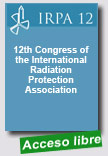 |
12th International Congress of the International Radiation Protection Association (IRPA) Proceedings
IRPA 12 Web Site, 2009, s. p.
The proceedings of the 12th International IRPA Congress in Buenos Aires are now available on the IRPA 12 Web Site. These proceedings include: audio presentations from the Opening and Closing ceremonies; the Sievert Lecture presented by Prof. Christian Streffer, Radiological Protection: Challenges and fascination of biological research. The lecture is available in PDF and can be found on the Web Site Plenary page; papers from the Plenary sessions, including the Special Papers by Dr.
|
Thomas Teneforde, NCRP President, Low dose and low-dose-rate radiation effects and models; and Prof. Roger Clarke, the ICRP 80th Anniversary: The evolution of its policies through 80 years; keynote Lectures in PDF format; Special Technical Session papers , also as PDF files; the Technical Session oral papers are presented as PDF files; Refresher Course presentations as PowerPoint or full paper PDF files; seminars as PDF files; the Full Papers are presented as PDF or WORD files. In some cases the full papers are not available, but the abstracts are presented.
Extraído de: http://www.irpa.net/
|
 |
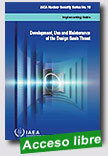 |
This publication provides guidance on how to develop, use and maintain a design basis threat (DBT). It is intended for decision makers from organizations with roles and responsibilities for the development, use and maintenance of the DBT. This Implementing Guide: describes a DBT; identifies and recommends the roles and responsibilities of organizations that should be involved in the development, use and maintenance of a DBT; describes how to conduct a national threat assessment |
as a precursor to a DBT; explains how a DBT can be developed; explains how a DBT is incorporated into a State’s nuclear security regime; and explains the conditions for a review of the DBT, and how the review and update are conducted.
Extraído de:
http://www-pub.iaea.org/MTCD/publications/PubDetails.asp?pubId=8097
|
 |
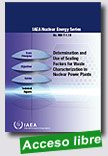 |
Determination and Use of Scaling Factors for Waste Characterization in Nuclear Power Plants
IAEA Nuclear Energy Series, 2009, 132 p.
This publication will assist Member States with the formation and implementation of efficient strategies for safe and cost effective classification and disposal of nuclear wastes. By exploiting the benefits of the scaling factor (SF) method of waste characterization, waste management professionals can facilitate the processing of larger quantities of heterogeneous radioactive waste. Whereas before, the complexity of quantifying difficult-to-measure (DTM) nuclides within sealed waste packages |
frustrated the efficient management of their disposal, the new SF methodology exploits known quantifiable ratios of DTM to easy-to-measure (ETM) nuclides so as to facilitate radioactive waste processing. This publication contains guidance and case studies from Member States where the technique has been successfully deployed, and provides an essential and effective complement to the recently published ISO standard 21238:2007 on the same topic.
Extraído de:
http://www-pub.iaea.org/MTCD/publications/PubDetails.asp?pubId=7985
|
 |
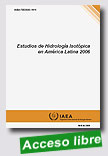 |
This publication summarizes the main findings and conclusions obtained from several hydrological studies conducted in Latin America, involving the use of hydrochemical and isotope tools. The studies were carried out in eleven aquifers in seven Latin American Member States as part of a Technical Cooperation Project conducted between 2001 and 2005. The main aspects addressed in the isotope studies were related to groundwater origin and dynamics; interconnection between surface waters and groundwaters; groundwater flow patterns; groundwater modelling; and vulnerability to pollution.
|
Extraído de:
http://www-pub.iaea.org/MTCD/publications/PubDetails.asp?pubId=8043
|
 |
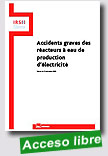 |
Accidents graves des réacteurs à eau de production d’électricité
Institut de Radioprotection et de Sûreté Nucléaire (IRSN), 15 Décembre 2008, 53 p.
Ce document présente les grandes lignes des connaissances actuelles sur les accidents graves des Réacteurs à Eau sous Pression (REP).
Tout d'abord, le document expose la physique de la fusion du cœur d'un REP et les modes de défaillance possibles de l'enceinte de confinement dans un tel cas. Ensuite, il présente les dispositions mises en place à l'égard de tels accidents en |
France, en particulier l'approche pragmatique qui prévaut pour les réacteurs déjà construits. Enfin, le document aborde le cas du réacteur EPR, pour lequel le dimensionnement tient compte explicitement des accidents graves : il s'agit alors d'objectifs de conception et leur respect doit faire l'objet d'une démonstration rigoureuse, en tenant compte des incertitudes.
Extraído de:
http://www.irsn.fr/index.php?page=Librairie/Documentsreference |
 |
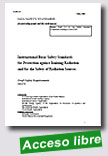 |
Draft 2.0 of International Basic Safety Standards
IAEA, May 2009, 142 p.
The IAEA has provided access to Draft 2.0 of the revised International Basic Safety Standards for Protection against Ionizing Radiation and for the Safety of Radiation Sources, and requested comments from IRPA. I encourage all IRPA Associate Societies to review this Draft 2.0 and provide your consolidated comments to me (kr.kase@stanfordalumni.org) and the IRPA Executive Officer (irpa.exof@irpa.net). Comments received by 10 June will be consolidated as IRPA comments and provided to the Radiation Safety Standards Committee (RASSC) for their |
June meeting. If your society cannot provide comments by that date, please continue with your review and provide comments before 15 September. I will include those comments in a consolidated set of comments from IRPA for the November RASSC meeting. This is a very important opportunity for IRPA to participate in this review and comment period before the draft BSS is sent for comment to the member states sometime next year.
Extraído de:
http://www-pub.iaea.org/MTCD/publications/PubDetails.asp?pubId=7906
|
 |
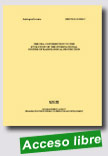 |
The NEA Contribution to the Evolution of the International System of Radiological Protection Nuclear Energy Agency (NEA), 31-Mar-09, 122 p.
Since the International Commission on Radiological Protection (ICRP) initiated a dialogue in 1999 on the evolution of the system of radiological protection, the NEA Committee on Radiation Protection and Public Health (CRPPH) has actively engaged in providing the ICRP with input and views. The Committee’s work on this subject has included eight expert group reports, seven international conferences, and four detailed review and comment assessments of draft ICRP recommendations. This report presents a chronological
|
summary of the issues, views and concerns raised by the CRPPH as the ICRP issued various draft versions of its new recommendations (ICRP Publication 103, published in December 2007), and of the response by the ICRP as seen in its subsequent draft recommendations. The interest of this summary report is that it will not only assist readers in understanding the main themes and concepts of the new ICRP recommendations, but also why and how the changes from the previous ICRP Publication 60 recommendations came about.
This publication is also available in French as: La contribution de l'AEN à l'évolution du système international de protection radiologique
http://www.nea.fr/html/rp/reports/2009/nea6441_Evolution_Systeme_Int_PR.pdf
Extraído de:
http://www.nea.fr/html/pub/ret.cgi?id=new#6440
|
 |
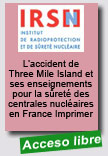 |
L'accident de Three Mile Island et ses enseignements pour la sûreté des centrales nucléaires en France
Institut de Radioprotection et de Sûreté Nucléaire (IRSN), 27/03/09, s. p.
Le 28 mars 1979, à la centrale nucléaire de Three Mile Island en Pennsylvanie (Etats-Unis), une série de défaillances matérielles et humaines provoquaient la fusion partielle du cœur du réacteur nucléaire. Trente ans après, l’IRSN propose un dossier qui revient sur les causes de cet accident et détaille les nombreuses leçons qui en ont été tirées pour améliorer la sûreté des centrales nucléaires dans le monde.
|
|
 |
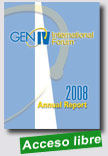 |
Generation IV International Forum (GIF) 2008 Annual Report
GIF, March 2009, 64 p.
This 2008 Annual Report is the second annual report issued by GIF. It provides an update on the GIF organization, membership, and participation in R&D projects for each Generation IV system. It summarizes the milestones for development of each system and progress of the R&D toward their accomplishment. Finally, it includes a brief description of the cooperation between GIF and other international endeavors for the development of nuclear energy. |
Extraído de: http://www.gen-4.org/GIF/About/index.htm |
 |
| |
|
|
|
| |
|
